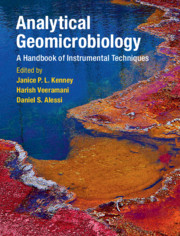Book contents
- Analytical Geomicrobiology A Handbook of Instrumental Techniques
- Analytical Geomicrobiology
- Copyright page
- Contents
- Contributors
- Foreword
- Part I Standard Techniques in Geomicrobiology
- Part II Advanced Analytical Instrumentation
- Part III Imaging Techniques
- 5 Scanning Probe Microscopy
- 6 Applications of Scanning Electron Microscopy in Geomicrobiology
- 7 Applications of Transmission Electron Microscopy in Geomicrobiology
- 8 Whole Cell Identification of Microorganisms in Their Natural Environment with Fluorescence in situ Hybridization (FISH)
- Part IV Spectroscopy
- Part V Microbiological Techniques
- Index
- References
6 - Applications of Scanning Electron Microscopy in Geomicrobiology
from Part III - Imaging Techniques
Published online by Cambridge University Press: 06 July 2019
- Analytical Geomicrobiology A Handbook of Instrumental Techniques
- Analytical Geomicrobiology
- Copyright page
- Contents
- Contributors
- Foreword
- Part I Standard Techniques in Geomicrobiology
- Part II Advanced Analytical Instrumentation
- Part III Imaging Techniques
- 5 Scanning Probe Microscopy
- 6 Applications of Scanning Electron Microscopy in Geomicrobiology
- 7 Applications of Transmission Electron Microscopy in Geomicrobiology
- 8 Whole Cell Identification of Microorganisms in Their Natural Environment with Fluorescence in situ Hybridization (FISH)
- Part IV Spectroscopy
- Part V Microbiological Techniques
- Index
- References
Summary
From mineralized biofilms of ancient or “extreme” environments to the nth replicate of laboratory-based biofilm experiments, geomicrobiological samples containing microbes associated with primary minerals or secondary (biogenic) mineral precipitates are highly diverse. The foremost advantage of scanning electron microscopy for geomicrobiology is that it provides high-resolution micrographs of cells and biofilms in association with minerals. These micrographs provide visual evidence of biogeochemical processes, which helps to explain phenomena that occur in the natural environment or in the laboratory. In addition to high-resolution secondary electron or backscatter electron modes of imaging, scanning electron microscopes can be equipped with a range of microanalytical tools, thereby extending the breadth of analytical capacities. Analytical techniques such as energy dispersive spectroscopy and electron backscatter diffraction analysis characterize the chemical composition and crystallography of biofilms and (bio)minerals, respectively, down to the micrometer scale. In addition, a focused ion beam can be used for nanomachining samples to provide a view beneath the outer surface of a sample or can be used as a technique for preparing samples for transmission electron microscopy. To provide the reader with an overview of tools and techniques, this chapter will explain a number of widely used preparation techniques, including whole-mounts, petrographic thin sections, polished blocks, and focused ion beam milling. By using these techniques, various types of geomicrobiological materials will be examined and used to guide and develop the necessary skills for interpreting biogeochemical processes from structural and chemical information obtained through secondary electron and backscatter electron micrographs and associated microanalyses.
- Type
- Chapter
- Information
- Analytical GeomicrobiologyA Handbook of Instrumental Techniques, pp. 148 - 165Publisher: Cambridge University PressPrint publication year: 2019
References
6.8 References
- 6
- Cited by

